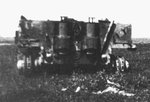That's what I said Soren!
Thinking about it though, German ammo wasn't that good;
Care to prove it ? Wait, don't bother, cause you can't. Why ? Cause its untrue! British and German AP projectile were the best throughout WW2.
The Jumbo was almost impervious to frontal attack, equal or even better than the KingTiger!! - though like the Churchill, lacking in offensive power.
What ???!!!!!
The Tiger Ausf.B's glacis is 150mm thick and sloped at 50 degrees from vertical, the Jumbo's glacis is 100mm thick and sloped at 47 degrees from vertical ! So as you can see the Tiger Ausf.B is enormously better protected from the front than the Jumbo, you can't even compare the two !
And since the Jumbo had a pea-shooter of a gun it was a Cow on the battlefield, no match for the KingTiger which could knock it out at distances exceeding 2km. Heck even the Tiger Ausf.E could take out the Jumbo frontally at a distance of 1km, just by aiming at the turret. The Panther could do the same at a 1.5km distance. Truth is, against the AT and tank-guns of the time, the Jumbo was anything BUT impervious to AT fire.














